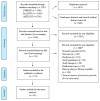Holistic Assessment of Factors Associated with Exhaustion, the Main Symptom of Burnout: A Meta-Analysis of Longitudinal Studies
- PMID: 36293607
- PMCID: PMC9602979
- DOI: 10.3390/ijerph192013037
Holistic Assessment of Factors Associated with Exhaustion, the Main Symptom of Burnout: A Meta-Analysis of Longitudinal Studies
Abstract
Background: This meta-analysis summarized longitudinal findings pertaining to exhaustion's predictors. In so doing, our aim was ultimately to identify target factors for the prevention of burnout.
Methods: We searched for studies that (a) examined predictors of exhaustion longitudinally and (b) reported correlation coefficients as an effect estimate. We conducted our literature search in three databases: MEDLINE, PsycINFO, and Embase. We focused on studies published between January 1990 and November 2020. Predictors were grouped into families, subfamilies, and subgroups. A meta-analysis of z-transformed correlation coefficients (rho) was performed. The results were scrutinized in relation to studies' follow-up length.
Results: We included 65 studies assessing 242 predictors of different types captured across different occupations. Our findings highlighted mostly weak associations (rho < 0.30). For six predictors-Job control, Job resources, Interactions at work, Communication and leadership, Job attitudes, and Work-family interface-longer length of follow-up involved weaker associations with exhaustion. The quality of the evidence available was generally low.
Conclusions: The evidence available does not point to clear target factors for preventing burnout. The decrease in associations as the follow-up length increases may suggest a relatively short latency period, followed by recovery. Higher-quality cohorts should be conducted to better understand the etiology and course of burnout.
Keywords: exposure assessment; exposure-response relationship; latency period; outcome measurement; predictor; stress.
Conflict of interest statement
The authors declare no conflict of interest. The funders had no role in the design of the study; in the collection, analyses, or interpretation of data; in the writing of the manuscript; or in the decision to publish the results.
Figures
Similar articles
-
How Do Areas of Work Life Drive Burnout in Orthopaedic Attending Surgeons, Fellows, and Residents?Clin Orthop Relat Res. 2021 Feb 1;479(2):251-262. doi: 10.1097/CORR.0000000000001457. Clin Orthop Relat Res. 2021. PMID: 32858718 Free PMC article.
-
An assessment of burnout in undergraduate athletic training education program directors.J Athl Train. 2009 Mar-Apr;44(2):190-6. doi: 10.4085/1062-6050-44.2.190. J Athl Train. 2009. PMID: 19295965 Free PMC article.
-
Burnout in nursing: a theoretical review.Hum Resour Health. 2020 Jun 5;18(1):41. doi: 10.1186/s12960-020-00469-9. Hum Resour Health. 2020. PMID: 32503559 Free PMC article.
-
The home care work environment's relationships with work engagement and burnout: A cross-sectional multi-centre study in Switzerland.Health Soc Care Community. 2020 Nov;28(6):1989-2003. doi: 10.1111/hsc.13010. Epub 2020 May 4. Health Soc Care Community. 2020. PMID: 32364334
-
Personal and work-related factors associated with nurse resilience: A systematic review.Int J Nurs Stud. 2019 May;93:129-140. doi: 10.1016/j.ijnurstu.2019.02.014. Epub 2019 Mar 5. Int J Nurs Stud. 2019. PMID: 30925279
Cited by
-
Measurement of compassion fatigue in animal health care professionals: a systematic review of available instruments and their content validity.Front Vet Sci. 2024 Jul 26;11:1425741. doi: 10.3389/fvets.2024.1425741. eCollection 2024. Front Vet Sci. 2024. PMID: 39132439 Free PMC article.
-
Disproportionately High Rates of Burnout Among Disabled Caregivers During the COVID-19 Pandemic.Res Sq [Preprint]. 2024 May 22:rs.3.rs-4391256. doi: 10.21203/rs.3.rs-4391256/v1. Res Sq. 2024. PMID: 38826445 Free PMC article. Preprint.
-
Psychometric validity of the Shirom-Melamed Burnout Measure and the Burnout Assessment Tool: a systematic review.Arh Hig Rada Toksikol. 2023 Dec 29;74(4):238-245. doi: 10.2478/aiht-2023-74-3769. eCollection 2022. Arh Hig Rada Toksikol. 2023. PMID: 38146759 Free PMC article.
-
Moral distress measurement in animal care workers: a systematic review.BMJ Open. 2024 Apr 19;14(4):e082235. doi: 10.1136/bmjopen-2023-082235. BMJ Open. 2024. PMID: 38643012 Free PMC article.
-
Burnout and Depressive Symptoms in Healthcare Professionals: A Cross-Sectional Study in Saudi Arabia.Healthcare (Basel). 2022 Dec 5;10(12):2447. doi: 10.3390/healthcare10122447. Healthcare (Basel). 2022. PMID: 36553971 Free PMC article.
References
-
- Word Health Organization Burn-Out an “Occupational Phenomenon”: International Classification of Diseases. [(accessed on 28 May 2019)]. Available online: https://www.who.int/news/item/28-05-2019-burn-out-an-occupational-phenom....
-
- American Psychiatric Association . Diagnostic and Statistical Manual of Mental Disorders. American Psychiatric Association; Washington, DC, USA: 2013.
-
- Guseva Canu I., Marca S.C., Dell’Oro F., Balázs Á., Bergamaschi E., Besse C., Bianchi R., Bislimovska J., Koscec Bjelajac A., Bugge M., et al. Harmonized definition of occupational burnout: A systematic review, semantic analysis, and Delphi consensus in 29 countries. Scand. J. Work. Environ. Health. 2021;47:95–107. doi: 10.5271/sjweh.3935. - DOI - PMC - PubMed
-
- Shirom A., Melamed S. A comparison of the construct validity of two burnout measures in two groups of professionals. Int. J. Stress Manag. 2006;13:176–200. doi: 10.1037/1072-5245.13.2.176. - DOI
Publication types
MeSH terms
Grants and funding
LinkOut - more resources
Full Text Sources



